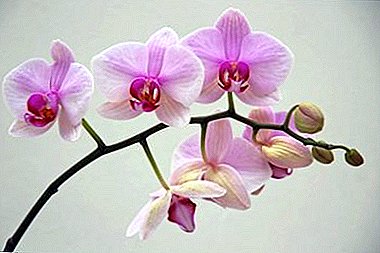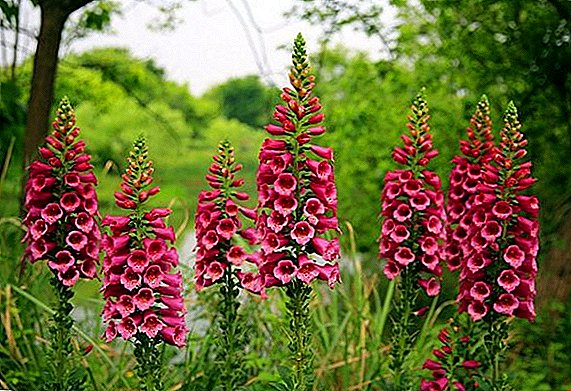 Digitalis or its Latin name digitalis (Digitalis), which translates as a finger. The name of the plant received for the shape of the corolla, it resembles a thimble, from this went the Russian name - foxglove. This herb belongs to the plantain family. In the world there are 25 species of plants known to man. Germinates throughout Europe, West Asia and North Africa. All of them are united by the fact that they contain digoxin, which belongs to the group of cardiac glycosides.
Digitalis or its Latin name digitalis (Digitalis), which translates as a finger. The name of the plant received for the shape of the corolla, it resembles a thimble, from this went the Russian name - foxglove. This herb belongs to the plantain family. In the world there are 25 species of plants known to man. Germinates throughout Europe, West Asia and North Africa. All of them are united by the fact that they contain digoxin, which belongs to the group of cardiac glycosides.
Important! Digoxin, although extremely effective in treating cardiovascular insufficiency, but in large quantities is a deadly poison!Consider the most common types of digitalis.
Digitalis yellow (Digitalis lutea)
Digitalis yellow - a perennial plant that grows wild in the steppes and forests of southern, western and central Europe. Height reaches 80-100 cm. Stems are smooth, smooth, upright. The leaves are long, have a longitudinal oval shape. Brush-inflorescence grows on the stems, each brush is covered with yellow, light yellow flowers. The flower is small, longer than three centimeters. Brown sprinkling is present on some specimens. Pretty calm transfers winter. When breeding foxglove yellow in the garden in the harsh winter, it is recommended to build a shelter on the plant. Blooms in early July and blooms until the end of August. 
Did you know? Due to its amazing appearance, it was noticed by gardeners in the middle of the XVI century and is still a good and bright decoration for the garden.
Digitalis grandiflora
Digitalis grandiflora - perennial plant or biennial when grown in gardens. It grows in Western Europe, Asia and Siberia. Very often it can be found on the meadows, rocky terrain and among the thickets of shrubs. Shoots reach a height of 120 cm. The stalk is smooth and pubescent, sometimes branches at the bottom. The leaves have an oblong, lanceolate form. Their size increases from the top of the stem down. Flowers in the foxglove large-flowered large, reach a length of 4-5 cm. The flowers can be both light yellow and rich yellow with brown sprinkling. The brush on which flowers grow is somewhat smaller in size than in other species, reaches 20-25 cm.  This type of foxglove blooms in the second year after planting. In the wild, it propagates by self-sowing, for planting in the garden it is better to use seedlings grown in greenhouses and greenhouses, which are planted before winter or in early spring.
This type of foxglove blooms in the second year after planting. In the wild, it propagates by self-sowing, for planting in the garden it is better to use seedlings grown in greenhouses and greenhouses, which are planted before winter or in early spring.
Important! The fruit of all types of foxglove is a cone-shaped, blunt-shaped box in a length of 8-12 mm.
Digitalis purpurea (Digitalis purpurea)
Purple foxglove is a perennial plant, gardeners grow it as a two-year-old, since in the third year it ceases to bloom, losing its decorative effect, or dies completely. Found in the wild throughout Europe and North Africa. Digitalis purpurea reaches a height of 150-200 cm. Its racemes grow by 80-90 cm. On each inflorescence a lot of bell-shaped tubular flowers that reach a length of 6 cm appear during flowering. The color of the petals is not only purple, it can be white , pink, purple and cream. Also, the petals are dotted with very neat dots and spots of a darker shade than the petal itself. The leaves have an oval-lanceolate form - 35-40 cm.  The color of the leaves varies from dark green at the top of the plant to grayish below. This is due to the fact that the leaves in digitalis densely pubescent. Blooms in June and blooms almost all summer.
The color of the leaves varies from dark green at the top of the plant to grayish below. This is due to the fact that the leaves in digitalis densely pubescent. Blooms in June and blooms almost all summer.
If you remove the dried inflorescences, the foxglove will form new floral brushes. This species is one of the most unpretentious to the conditions of cultivation, it grows in almost any soil with a share of chernozem, except acidic soils. It is drought-resistant and winter-resistant, likes penumbra, but can develop in the sun, if sufficient moisture is maintained. This type of foxglove is the most popular among gardeners and has many varieties: "carousel" - caramel petals, "white giant" - white petals, "spotted giant" - white petals with purple accents, "speck" - bright crimson petals with burgundy dots and a number of other varieties.
Digitalis small-flowered (Digitalis parviflora)
Digitalis small-flowered - perennial herbaceous plant, was first seen in the mountainous regions of Portugal and Spain. Very undersized foxglove, dwarf compared to other species - its height is only 40-60 cm. The stem is straight, smooth, has a darkish-purple color. The leaves of the small-flowered foxglove are reduced in size from bottom to top, have a fringed, ovoid shape, pointed at the end. Downy pubescent, and naked on top. The flower of this foxglove is very small, its length reaches 1-2 cm. The petals are dark purple or reddish brown in color with purple veins. Brush-inflorescence reaches a length of 10 cm. The foxglove of small-flowered blooms in July and blooms until autumn. This type of frost resistant, can withstand temperatures up to -20 ° C. Light-requiring 
Digitalis rusty (Digitalis ferruginea)
The rusty foxglove is a perennial herbaceous plant that grows in Southern Europe and Western Asia. This is a high foxglove - 150 cm. The stem is simple, equidistant. In the lower part has a hairy cover, and in the top cover is missing. The lower leaves reach a length of 30 cm, have an oblong, lanceolate shape with clearly distinguished veins, moderately pubescent. The upper leaves of the foxglove are sharp and sessile, smoothly turning into bracts. Flowers in length - up to 4 cm, they are numerous and gathered in large inflorescences. Brush-inflorescence reaches a length of 50 cm. 
Did you know? Digitalis woolly and digitalis large-flowered - the only types of foxglove, which were listed in the Red Book of the USSR. And now they are under protection in some CIS countries.
Flowers themselves are different from other species and resemble orchid flowers in shape. The color of the petals may be light yellow, brown yellow, green yellow with brown or purple specks. In the flowers of this species is clearly expressed lower lip. It blooms from June to August, blooms in the second year after seed sowing. It tolerates the winter period.
Digitalis woolly (Digitalis lanata)
Digitalis woolly - perennial herbaceous plant, in culture divorced as a two-year. Grows in Eastern Europe and Western Asia. Predominantly grows in meadows, clay slopes, deciduous forests and shrubs. The foxglove is medium in size and reaches a height of 100 cm. The stem of the plant is straight, in the lower part it is naked, and densely pubescent in the upper part. The lower leaves are oblong, lanceolate and pubescent, 12 cm long. The upper leaves are sessile - the closer to the top of the stem, the stronger they turn into bracts, slightly pubescent. The flowers are large, up to 4 cm. The color of the petals is yellow or brown-yellow. The lower lip is white. Petals quite noticeably pubescent.  Brush-inflorescence has a length of up to 50 cm. Brush unilateral, with densely arranged flowers on it. The foxglove woolly blooms in July and blooms until the end of August. Loves open and bright terrain. It does not tolerate severe frosts.
Brush-inflorescence has a length of up to 50 cm. Brush unilateral, with densely arranged flowers on it. The foxglove woolly blooms in July and blooms until the end of August. Loves open and bright terrain. It does not tolerate severe frosts.












